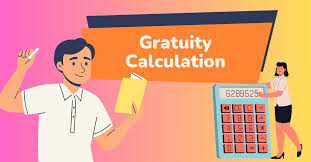Gratuity is a financial gesture primarily aimed at rewarding employees for their service upon retirement, resignation, or termination. For government employees in India, calculating gratuity can initially seem complex. However, with the right formula and understanding, it becomes straightforward. This article will guide you step-by-step on How to Calculate Gratuity for Government Employees. We will also explore the Gratuity Meaning, presenting detailed calculations in Indian Rupees (INR).
Understanding Gratuity Meaning
Before diving into the calculation, it’s crucial to understand Gratuity Meaning. Gratuity is a lump sum benefit provided by an employer to an employee as a token of appreciation for their long-term service to the organization. It is governed by the Payment of Gratuity Act of 1972, which stipulates that an employee is eligible for gratuity after completing a minimum of five years of service.
Gratuity Calculation Formula
For government employees in India, the formula to calculate gratuity is relatively straightforward:
\[ \text{Gratuity} = \text{(Last drawn salary)} \times \text{(years of service)} \times \frac{15}{26} \]
Where:
– Last drawn salary includes basic salary plus dearness allowance (DA).
– Years of service is the total number of years the employee has worked in government service.
– The number 15 represents the 15 days salary provided as gratuity for each completed year of service.
– The number 26 represents the number of working days in a month.
Detailed Calculation with Example
Let’s break down the formula with a practical example to understand How to Calculate Gratuity for government employees.
Step 1: Determine the Last Drawn Salary
Assume the last drawn salary (basic pay + DA) is INR 50,000 per month.
Step 2: Calculate Years of Service
Suppose the employee has served for 25 years.
Step 3: Apply the Formula
\[ \text{Gratuity} = 50,000 \times 25 \times \frac{15}{26} \]
Step 4: Simplify the Calculation
\[ = 50,000 \times 25 \times 0.5769 \]
\[ = 50,000 \times 14.4225 \]
\[ = 721,125 \]
Therefore, the gratuity amount for the employee would be INR 721,125.
Points to Consider
Ceiling on Gratuity Amount
For government employees, the maximum gratuity amount is currently capped at INR 20,00,000. If the computed gratuity exceeds this limit, the employee will receive the capped amount.
Eligibility Criteria
An employee should have completed a minimum of five years of continuous service to be eligible for gratuity. However, in case of death or disability due to accident or disease, this condition does not apply.
Computation of Partial Years
For calculations, a period of six months or more is to be considered as one whole year. For instance, if an employee has completed 25 years and 7 months of service, it will be considered as 26 years for gratuity calculation.
Taxation on Gratuity
Tax-Exempt Gratuity
As per current regulations, the gratuity received by government employees is wholly tax-exempt under Section 10(10)(i) of the Income Tax Act, 1961.
Taxable Gratuity
If the gratuity amount exceeds the exempted limit for non-government employees, the excess portion becomes taxable under the head ‘Income from Salary’. However, this scenario does not usually apply to government employees since their gratuity is fully exempted.
Filing Gratuity Claims
To claim gratuity, government employees need to fill out Form I under the Payment of Gratuity Act and submit it to the employer. The employer, upon verifying the claim, will process the gratuity payment typically within 30 days from the date of cessation of employment.
Gratuity for Death and Disability
In cases where employees die while in service, the gratuity calculation formula alters slightly to benefit the dependents. The family members are entitled to a gratuity calculated based on the service the employee would have rendered till the superannuation date. Similar benefits are applicable in cases of permanent disability.
Conclusion
Gratuity serves as a significant parting reward for the invaluable services rendered by government employees. Understanding How to Calculate Gratuity using the provided formula ensures employees receive what they rightfully deserve. Always ensure every aspect is comprehensively understood and all procedural formalities are accurately furnished to avoid discrepancies.
Disclaimer
The information presented here is based on current regulations and formulas governing gratuity for government employees in India. The reader must consult a financial advisor or legal expert for personalized advice. The investor must gauge all the pros and cons of trading in the Indian financial market.
Summary:
This comprehensive guide explores How to Calculate Gratuity for Government Employees in India. Gratuity, a retirement or resignation benefit, signifies an employer’s gratitude for an employee’s service. The gratuity calculation for government employees follows the formula: \[ \text{Gratuity} = \text{(Last drawn salary)} \times \text{(years of service)} \times \frac{15}{26} \] Here, the ‘last drawn salary’ includes the basic pay plus dearness allowance, while the ‘years of service’ represent the total period an individual has worked. This guide also addresses specific considerations such as the threshold limit of INR 20,00,000, the tax exemptions under Section 10(10)(i) for government employees, and the procedural formality of filing claims with Form I. Additionally, special provisions for cases of death and disability, and how partial years are computed, are also discussed. This article serves as a detailed roadmap for government employees to navigate their gratuity calculations effectively.
Disclaimer:
Investors must evaluate all aspects of trading in the Indian financial market and may seek personalized counsel.


